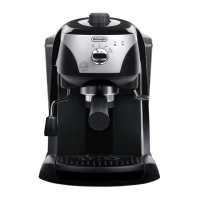6.To detach the filter holder, turn the handle from right
to left.
ATTENTION: to avoid spraying, never detach the
filter holder while the machine is brewing coffee.
7.To remove the used coffee, hold the filter locked with
the special lever that is built into the handle and let
the coffee fall out by knocking the overturned filter
holder (Fig. 13).
8.To switch off the coffee machine, turn the selector knob
on the appliance to the OFF position “O” (fig. 14).
HOW TO PREPARE COFFEE USING THE FILTER
HOLDER FOR PODS (if fitted):
•Preheat the machine as described in the
‘Preheating the Coffee Machine’ section, making
sure to leave the filter holder attached to the unit.
Following this procedure ensures that the coffee is
delivered at a hotter temperature, as well as
guaranteeing that the seal of the filter holder
gaskets is more effective.
•Press the filter holder button and insert the pod into
the filter (fig 15).
Note: Use pods which conform to the ESE standard:
this will be indicated on the packaging by the
following symbol:
The ESE standard is a system accepted by the leading
coffee pod manufacturers, and allows espresso
coffee to be prepared simply and without any mess.
3.Attach the filter holder onto the machine, moving
from left to right (fig 6).
IMPORTANT: Should the coffee holder for pods be
used after one for ground coffee, it’s necessary to
clear the ground coffee remained in the espresso
boiler outlet. This cleaning operation is necessary in
order to avoid water leakages from the coffe
holder for pods while coffee is being prepared.
4.Proceed as in points 4, 5 and 6 in the previous
section on how to prepare espresso.
5.To remove the pod, press the button on the filter
holder and simply lift the pod out
6.To turn the coffee machine off, turn the selector knob on
the appliance to the Off position “O” (fig.14).
If you use the “iIIycaffe” coffee pods, use the special
filter holder. Insert the coffee pod ensuring the name
“iIIy” is facing down and the long side of the pod is
positioned as showned in figure.
HOW TO MAKE CAPPUCCINO
1.Prepare espresso coffee, using cups that are large
enough for cappuccinos (see “How to prepare
espresso coffee).
2.Turn the selector knob to the position (fig. 16)
Wait until the orange “OK” light comes on, to
indicate that the boiler has reached the ideal
temperature for producing steam.
3.In the meantime, fill a container with approximately
3 fl. oz of milk for each cappuccino to be prepared.
The milk must be cold from the refrigerator (not
warm!). In choosing the container, bear in mind that
the volume of the milk will increase by 2 or 3 times.
Semi skimmed milk gives best results.
NOTE: We suggest you use semi-skimed milk at
refrigerator temperature.
4.Position the container with the milk in it under the
milk frother (fig. 17).
5.Immerse the cappuccino maker nozzle about 5mm
deep into the milk and turn the steam knob in an
anti-clockwise direction (fig. 18) (by turning the knob
to a greater or lesser extent, it is possible to vary the
quantity of steam that comes out from the cappuccino
maker). At this point, the milk will begin to increase
in volume and to appear frothy.
6.When the volume of the milk has doubled, fully
immerse the milk frother and continue heating the
milk (Fig. 19). Once the desired temperature has
been reached (the ideal temperature is 60°C), stop
the delivery of steam by turning the steam knob in a
clockwise direction and at the same time positioning
the selector knob at “O” (fig. 14).
7.Pour the frothed milk into the cups containing the
espresso coffee. Your cappuccino is now ready. Add
sugar to taste and, if desired, sprinkle a little
powdered chocolate on top of the froth.
Note:to prepare the coffee after having frothed the
milk, first let the boiler cool down, otherwise the
coffee will be burnt. To cool the boiler down, place a
container underneath the outlet, turn the selector
knob to the “espresso” position and allow the water
to flow out until the ‘OK’ light goes off. Return the
selector knob to the position and then prepare
the coffee as described in the previous paragraph.
8

